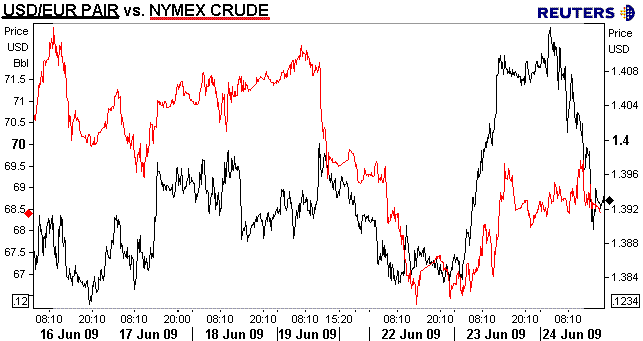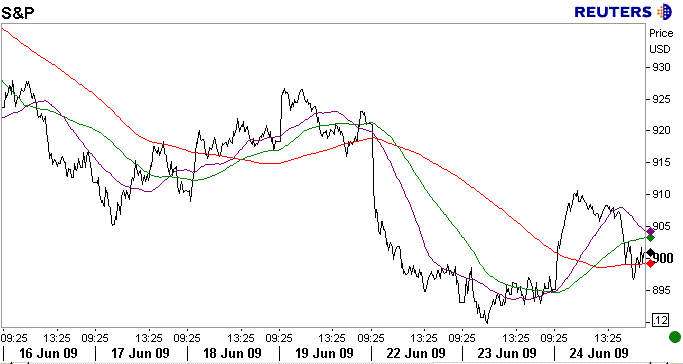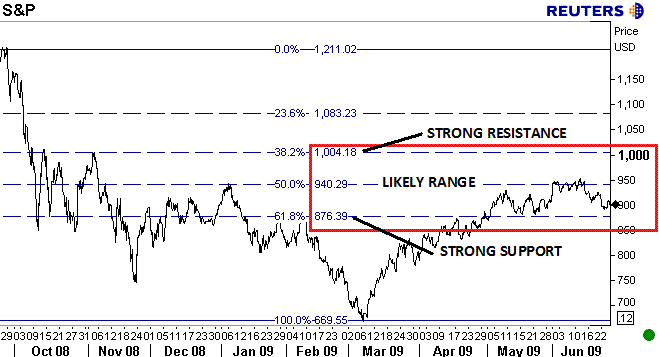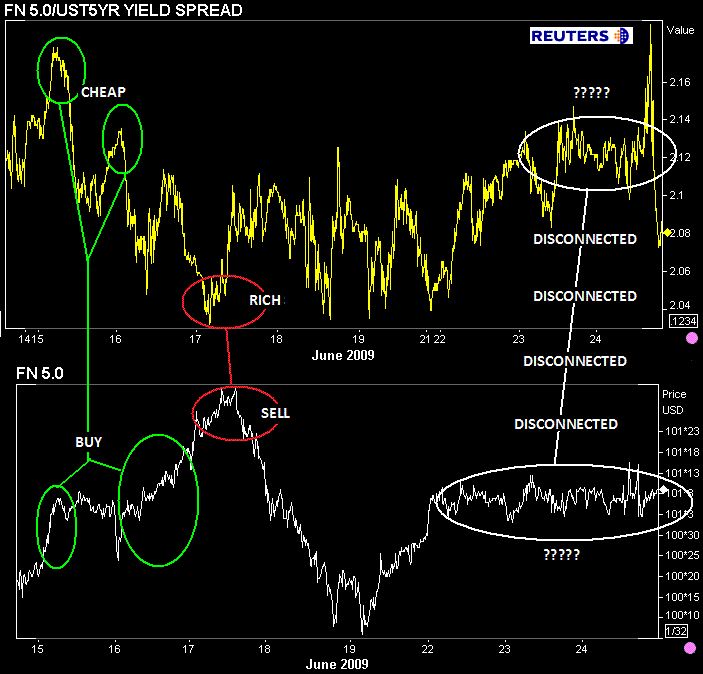The much anticipated FOMC meeting is behind us and, as most market participants expected, there were only slight "tweaks" made to the text of the policy statement. Although there is a lack of scientific backing behind doing this...let's analyze the implied meaning of the small adjustments made to the statement....
The first difference we noticed between the April statement and the June statement was the Fed's degree of confidence regarding the pace of economic contraction...
April Statement: "Information received since the Federal Open Market Committee met in March indicates that the economy has continued to contract, though the pace of contraction appears to be somewhat slower."
June Statement: "Information received since the Federal Open Market Committee met in April suggests that the pace of economic contraction is slowing"
This verbiage alteration would imply that recent economic data releases have reassured the FOMC enough to assertively announce that ECONOMIC CONTRACTION IS SLOWING. No big deal here...we agree that the worst case scenario has been avoided and stabilization (not recovery) is occurring. Furthering this feeling of stabilization was the term "added" being inserted into the June statement's text regarding household spending...
"Household spending has shown further signs of stabilizing but remains constrained by ongoing job losses, lower housing wealth, and tight credit"
The Fed also addressed their business inventory liquidation concerns. If this trend continues look for the Fed to remove the term "appears" in the August statement (you heard that right...no July meeting)...
April Statement: "Weak sales prospects and difficulties in obtaining credit have led businesses to cut back on inventories, fixed investment, and staffing"
June Statement: "Businesses are cutting back on fixed investment and staffing but appear to be making progress in bringing inventory stocks into better alignment with sales"
Reminder: inventory liquidation is a key factor in the Fed's economic outlook...from Ben Bernanke's prepared testimony, June 3, 2009, Before the House Budget Committee:
"We continue to expect overall economic activity to bottom out, and then to turn up later this year. Our assessments that consumer spending and housing demand will stabilize and that the pace of inventory liquidation will slow are key building blocks of that forecast."
The only other noticeable change to the policy statement was the removal of the April statement verbiage implying deflation had not yet been ruled out of the economic outlook. In the June statement the FOMC substituted some slightly more optimistic verbiage on deflation and even added an acknowledgement of high energy prices...but still did not back away from the fact that inflation will remain under control "FOR SOME TIME"....
April Statement: "In light of increasing economic slack here and abroad, the Committee expects that inflation will remain subdued. Moreover, the Committee sees some risk that inflation could persist for a time below rates that best foster economic growth and price stability in the longer term"
June Statement: "The prices of energy and other commodities have risen of late. However, substantial resource slack is likely to dampen cost pressures, and the Committee expects that inflation will remain subdued for some time."
We may have a complaint here, depending on how the market reacts of course...it may have been helpful if the Fed had clarified the time frame implied by the term "some time". On the other hand, outlining an inflationary time frame may have been a bad bad thing for fixed income as it would have clarified/justified the extent to which traders run up benchmark Treasury yields ahead of debt auctions. Either way, the lack of guidance still affords traders the opportunity to demand higher risk free yields as market participants will make their own verdict on the timeframe with which they expect inflation to warm up.
All in all the June FOMC statement was slightly more optimistic on stabilization....but the Fed did not forget to remind all that "economic activity is likely to remain weak for a time". Which we feel is important to remind all.
That
said....we feel like the Fed held back on housing, which they say is a top
priority in the recovery process...from prepared text of Ben Bernanke, The Economic Outlook, as read before
the Joint Economic Committee, May 5, 2009, U.S. Congress, Washington, D.C. :
"We continue to expect economic activity to bottom out, then to turn up later this year. Key elements of this forecast are our assessments that the housing market is beginning to stabilize and that the sharp inventory liquidation that has been in progress will slow over the next few quarters".
So the big event we have all been waiting for is over with....the Fed addressed inventory liquidation but failed to mention us... as in the housing industry. We were all really hoping for the inclusion of some insightful bit of information that might help focus the market's attention on the inefficiencies of the housing and mortgage sectors. Housing is after all one of the "key elements" of the recovery process. Right? I know I know, the Fed reiterated and remind re: MBS/TSY purchase program...but that kinda like getting your Christmas present in August (after begging for it)...remember that? I do. When Christmas day came (today) you felt kinda short changed. Thats the best concession I can make for the lack of housing related verbiage today. I think its safe to say that we all feel somewhat dissatisfied by the lack of housing/mortgage related "tweaks" made to the statement. The market just seems to apathetic/unaware of all the problems and issues that are affecting each and every purchase contract and new loan application. I wrote a rather heated/passionate argument for our cause. READ MBS LUNCH for more discussion on that....
ANYWAY...I have already spent too much time on my housing soap box this week (we're trying here)...so lets talk about the WHAT NOW question you are all likely waiting to have answered. btw you can jump on your soap box in the comment section if you are feeling frustrated...
Following the release of the FOMC statement, stock markets sold off as the value of the dollar improved on a lack of further Fed funding allocation for the Treasury/MBS purchase program...the dollar loved that the Fed decided to refrain from further balance sheet expansion.The value of the dollar and cost of commodities has played a rather large role in the movements of equities lately.
Notice as the value of the dollar declines (BLACK)...which illustrated by the line graph moving higher as the EUR gains on the USD...the price of the August NYMEX Crude contract rises. When the dollar strengthens (line graph moves lower)...the cost to purchase an NYMEX crude declines.....

Now check out how the S&P reacts to fluctuations in the value of the dollar and the cost of commodities. When the dollar strengthens and oil cheapens up....declines in energy stocks, basic-materials, and industrial stocks lead the S&P lower. This is based on a theory that a run up in oil prices was too fast and not supported by fundamentals...lots of people exiting long positions. We could also make the argument that the S&P is leading oil and the value of the dollar lower as the economic outlook turns from recovery to stabilization. Just depends on what day you ask, the street is reacting differently daily...fade one day, follow the next. Does the tail wag the dog or does the dog wag the tail?

Look for that relationship to continue as stock traders search for any sign that
corporations will be able to actually MAKE MONEY in the future. That is a
positive note for fixed income!!! Why? Well first off all the second derivative
trade appears to be dead (yes..take my use of the term "appears" to
imply the same level of confidence of the Federal Reserve in April). The second
derivative trade is the "green shoots" position. Still not following? In
April and May stocks were all excited because economic indicators were showing signs of
stabilization...meaning no more contraction or further falling data.
That sentiment has since exhausted as a further run up in equities is not justified by a pure avoidance of the worst case scenario. Today the Fed did a fine job of indicating that stabilization has occurred (see
above)...but that doesnt change the fact that companies still need to find a way to make money, revenue
models need to be reinvented, and then they have to be proven efficient.
Plain and Simple: Stock markets are no longer satisfied knowing that the pace of contraction (2nd derivative) has slowed. Now equity markets are looking for actual signs of recovery, they are looking for positive growth. This would imply that stock markets will likely be RANGE BOUND (tired of hearing that term?) until new information comes to light that offers some sort of guidance on HOW IN THE WORLD COMPANIES PLAN TO MAKE MONEY AND CREATE NEW JOBS. Savy?
When discussing a range in equities...here is some guidance as we head into the summer slumber on Wall Street.

So if stocks are range bound, does that mean Treasuries and MBS are too?
As of 5pm on June 24, 2009 we will say yes...but there are a lot of variables that could affect this stance...one big one is HOUSING (which would affect equities too). At this point I think we have made it quite clear that housing must play a major role in the recovery process. RIGHT? We believe this summer market participants will slowly but surely come to this realization. As new housing data presents itself and the perception of stabilization evolves into an acceptance of stagnation....the marketplace will hopefully grasp the fact that 14.5 million Americans are unemployed and therefore unable to qualify for the purchase of one of the 3.8 million unsold homes on the market (renting more economically efficient with almost 10 months supply of homes on the market?....that doesn't help and neither does the perception of high interest rates relative to previous months).
As far as our directional guidance giver goes...the yield curve. Here is a look at the 10 yr...

Yeh...all we can offer up at the moment is a short term outlook on fixed income. Quarter end is approaching so volume in markets will likely be well below normal. Any accounts trading will be doing so with a day trading mentality so....the range will moderate but who knows what will be moving money in the near term future. At this point we have to take one day at a time, one data release at a time, one Fed speaker at a time, one Treasury auction at a time...get the point?
That said...we will keep our RANGE BOUND until further notice outlook short term...as in tomorrow at most.
Here is a look at the MBS range...its all about relative value vs. our benchmark big brothers.

This can be a bit confusing....here is a quick explanation:
Leading up to the FOMC announcement, "rate sheet influential" MBS coupons were somewhat detached from the day trading fluctuations of the yield curve. MBS trading flows were light with GN coupons really the only "hot topic" after HUD comments implying more GN MBS supply was coming...the market didnt like that too much because Asia is the only sizeable buyer of FHA paper and the street is always skeptical of Asia's willingness to support US debt securities, so GN MBS coupons sold off more than FN and FGs.
ANYWAY, eventhough our benchmark big brothers were still offering directional guidance, as in TSYs sell -MBS sell, the trend of MBS/TSY yield spreads widening as TSYs sold and MBS tightening into a TSY rally has faded recently. Unfortunately that disconnected feeling may continue as we head into quarter end "window dressing" and accounts look to move into cash or an asset that is slightly more "comforting" balance sheet/AAA rating-wise. That said we will look to forward month MBS coupons, we will watch the roll for an idea of MBS demand to come.
In the mean time if TSYs sell, MBS will sell too. If TSYs rally, MBS will rally....the extent to which this will occur is hard to determine but we are in the camp that until July 1 MBS trading volumes and flows will be light as demand for mortgage-backs falls. MBS movement will be moderated by the perception of "cheapness" or "richness".....perhaps some month end supportive index buyers will add momentum to any rally but we dont expect that demand side support to last too long as balance sheet preparations will eventually even out any possible MBS gains we see between now and June 30.
One day at a time...with an extra focus on economic reports and "relative valuations".
2s vs. 10s: 247bps





